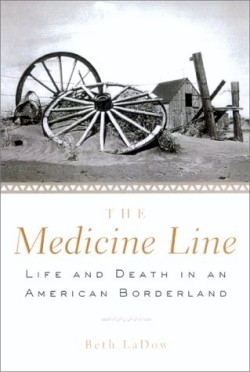The Medicine Line
Life and Death on a North American Borderland
“The word medicine among Northern Plains tribes applied to objects supposed to have magical influence or mysterious power,” writes LaDow. The medicine line is a 100-mile stretch of land in the Northwest, running along the U.S./Canadian border, and spilling over onto both sides. During the nineteenth century, Native Americans would cross this line to escape or evade one nation or the other. The area would also be the focus of intense homesteading between 1890 and 1920, becoming a melting pot of Native Americans and Europeans. The story of The Medicine Line is the epic of a desolate stretch of land and of the people who attempted to inhabit it.
LaDow begins her book with a vivid account of the surrender of Sitting Bull in 1881. The Canadians, while not particularly helpful to the Native Americans, left them to live as they pleased. Unfortunately, this was a meager existence because there were few remaining sources of food. The tribe would be left with the choice of returning to reservation life in the United States or starving. LaDow suggests that Sitting Bull’s surrender to the United States Army was more representative of the Native American experience in the late-1800s than the noted, heroic surrender of Chief Joseph of the Nez Percé. Economic necessity, not valor, would come to define Native-American life.
Latter-day homesteaders would be brought to the medicine line by false promises of prosperity only to be defeated by disease and bad weather. In 1918 and 1919 Spanish influenza ravaged the area. Farming, always an uncertain occupation in borderland country, became impossible due to the lack of rainfall following World War I. “Between 1919 and 1925, approximately two million acres of Montana farm land fell out of production,” LaDow writes. With little help from the government, homesteaders sold their land for what they could get and moved on.
LaDow portrays the medicine line as an antithesis to the myth of a prosperous west: the inhabitants, despite their best efforts, lived out harsh lives on barren land. Instead of answering their dreams, the land became a testing ground for the Americans, Canadians, Native Americans, and Europeans that came to dwell there. The Medicine Line offers a portrait of a land and of a people seldom covered in history textbooks, providing a more complete picture of the culture of the American West.
Reviewed by
Ronald D. Lankford, Jr.
Disclosure: This article is not an endorsement, but a review. The publisher of this book provided free copies of the book to have their book reviewed by a professional reviewer. No fee was paid by the publisher for this review. Foreword Reviews only recommends books that we love. Foreword Magazine, Inc. is disclosing this in accordance with the Federal Trade Commission’s 16 CFR, Part 255.

